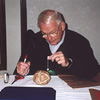The COSPIN instrument image page

This is a photograph of the Dual Anisotropy Telescopes (ATs). The ATs are outlined with a yellow line. The LET (Low Energy Telescope) is also shown outlined with a green circle. The cover shown in this picture covering the LET was opened after launch. The bottom third of the box actually contains the data processing unit (DPU). The DPU collects measurements from all of the telescopes on COSPIN and sends them to the spacecraft data system.
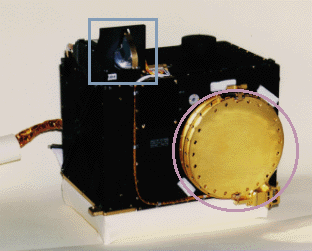
This is a photograph of the High Energy Telescope (HET) and the High Flux Telescope (HFT). The HFT is the small fan-shaped object on top of
the box (outlined in blue). The HET is outlined in purple. You can see that the HFT has a bronze strip covering it and the HET has a large, circular gold cover on it. Both of these covers were opened after launch.
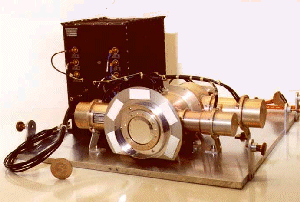
This is a photograph of the Kiel Electron Telescope (KET).
These are photographs of some of the sensors that make up the COSPIN instrument.
Images were adapted from ESA (European Space Agency) images
 Ulysses Instruments
Ulysses Instruments
You might also be interested in:
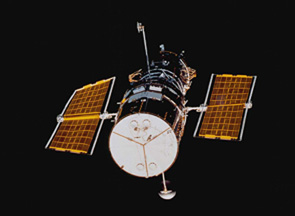
The Hubble Space Telescope (HST) was one of the most important exploration tools of the past two decades, and will continue to serve as a great resource well into the new millennium. The HST found numerous
...more
Driven by a recent surge in space research, the Apollo program hoped to add to the accomplishments of the Lunar Orbiter and Surveyor missions of the late 1960's. Apollo 11 was the name of the first mission
...more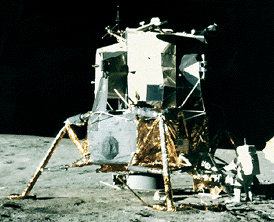
Apollo 12 was launched on Nov. 14, 1969, surviving a lightning strike which temporarily shut down many systems, and arrived at the Moon three days later. Astronauts Charles Conrad and Alan Bean descended
...more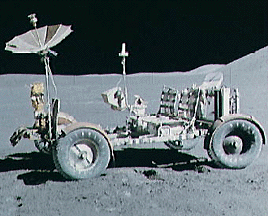
Apollo 15 marked the start of a new series of missions from the Apollo space program, each capable of exploring more lunar terrain than ever before. Launched on July 26, 1971, Apollo 15 reached the Moon
...more
NASA chose Deep Impact to be part of a special series called the Discovery Program on July 7, 1999. The Discovery program specializes in low-cost, scientific projects. In May 2001, Deep Impact was given
...more
The Galileo spacecraft was launched on October 19, 1989. Galileo had two parts: an orbiter and a descent probe that parachuted into Jupiter's atmosphere. Galileo's main mission was to explore Jupiter and
...more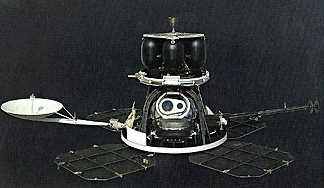
During 1966 through 1967, five Lunar Orbiter spacecrafts were launched, with the purpose of mapping the Moon's surface in preparation for the Apollo and Surveyor landings. All five missions were successful.
...more
 This is a photograph of the Dual Anisotropy Telescopes (ATs). The ATs are outlined with a yellow line. The LET (Low Energy Telescope) is also shown outlined with a green circle. The cover shown in this picture covering the LET was opened after launch. The bottom third of the box actually contains the data processing unit (DPU). The DPU collects measurements from all of the telescopes on COSPIN and sends them to the spacecraft data system.
This is a photograph of the Dual Anisotropy Telescopes (ATs). The ATs are outlined with a yellow line. The LET (Low Energy Telescope) is also shown outlined with a green circle. The cover shown in this picture covering the LET was opened after launch. The bottom third of the box actually contains the data processing unit (DPU). The DPU collects measurements from all of the telescopes on COSPIN and sends them to the spacecraft data system.
 This is a photograph of the High Energy Telescope (HET) and the High Flux Telescope (HFT). The HFT is the small fan-shaped object on top of
the box (outlined in blue). The HET is outlined in purple. You can see that the HFT has a bronze strip covering it and the HET has a large, circular gold cover on it. Both of these covers were opened after launch.
This is a photograph of the High Energy Telescope (HET) and the High Flux Telescope (HFT). The HFT is the small fan-shaped object on top of
the box (outlined in blue). The HET is outlined in purple. You can see that the HFT has a bronze strip covering it and the HET has a large, circular gold cover on it. Both of these covers were opened after launch.
 This is a photograph of the Kiel Electron Telescope (KET).
This is a photograph of the Kiel Electron Telescope (KET).



